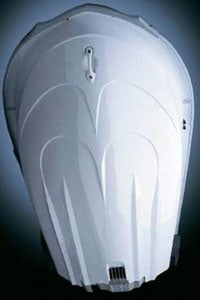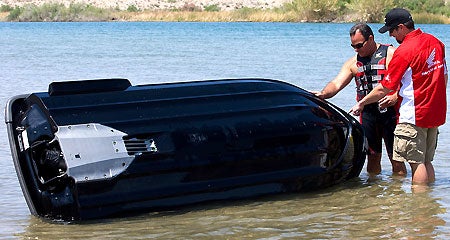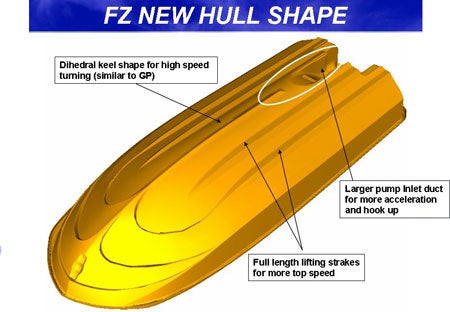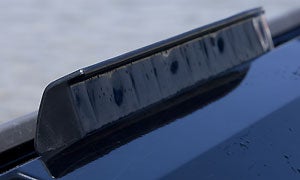Understanding PWC Hull Terminology
Chines, strakes, and sponsons...and how they affect your ride
Take a glance through the latest PWC reviews, or talk shop in your neighborhood showroom, and chances are you’ll hear a fair share of terms related to hull design. Stuff like V, strakes, chines, and sponsons, just to name a few. But unless you’ve got a background in boating, these terms may very well mean nothing to you. The areas and components of the hull they describe, however, can greatly affect your enjoyment of your craft.
Pick the ones that match your riding style and typical water conditions and you’ve got a winner. Choose wrong and you risk never fully enjoying your boat.
Want to get to know the nooks and crannies of your hull…or at least impress your friends at the next beach gathering? Here’s a quick guide to your ride.
 The hull of Yamaha’s WaveRunner VX.
The hull of Yamaha’s WaveRunner VX.V – Look at a PWC head on and you’ll notice the hull angles up from the bottom centerline, or the keel, toward both the starboard (right) and port (left) sides. That angle is known as the craft’s “V”. A deep-V means the angle is relatively sharp. That’s a desirable trait in rough water, as it allows the boat to slice through the waves, rather than be jarred atop them. The tradeoff is stability. With such a sharp angle, a hull may roll more from side to side.
Most of today’s PWC use a modified-V, a hull that has a sharper point at the bow, and then gradually softens as you follow its lines aft. The design gives a craft a better overall ride, with the sharper bow cleaving through the waves, and the flatter aft section enhancing stability and top speed.
The angle of a hull’s “V” at any given point fore-to-aft can be measured for comparison. That angle is known as deadrise.
Chines – A hull’s chines are the relatively abrupt corners where the vertical hull side and angular bottom actually meet. Hulls with a softer chine, like Yamaha’s new FZ designs, will roll more easily into a turn giving the boat an inside-lean personality, but sacrifice a little stability. Hulls with a hard, severe chine will be more stable, but perhaps not handle as intuitively.
 Honda AquaTrax F-15X hull.
Honda AquaTrax F-15X hull.Strakes – Look at the bottom of a hull between the chines and you’ll see raised, lengthwise ridges on each side of the keel. These are called strakes, and they create lift. As a PWC accelerates, it pushes water out and to the sides of the keel. That water is pushed against the strakes, where it then lifts the hull and helps push it onto plane. Once at speed and on top of the water, those same strakes improve speed by helping the hull to ride on less of its surface area.
It’s common to see more than one strake on each side of the keel. In theory, multiple strakes allow the craft to run higher and flatter atop the water, which is good for speed. It’s a balancing act, however, as too much lift will make the hull unstable. There will literally be too little of it contacting the water.
 Yamaha’s new FZ Series hull.
Yamaha’s new FZ Series hull.As you might expect, strakes also enhance tracking, as they bite into the water and help prevent sliding in a turn. Again, however, go too far and the craft may become too aggressive for the average rider. In this way, hull design is a science, but also an art.
 Sponsons on the F-15X.
Sponsons on the F-15X.Sponsons – Look at the aft corners of your hull. Those fins bolted along the hull sides are known as sponsons. Their primary purpose is to improve handling. Like a little outboard rudder, they help your boat stay hooked up through a tight turn. The larger and deeper the design, typically the more aggressive the resulting ride.
Though it’s not their primary function, sponsons also enhance stability, and provide a small amount of lift to the stern.
Steps – Like the name implies, a step is a distinct ledge in a hull’s bottom surface. Here’s the theory: as a PWC moves forward, water flows along the surface of the hull from front to back. That water provides the greatest lift at the hull’s leading edge, and then lessens as it moves farther toward the stern. Ultimately it creates drag, actually slowing the hull in the water.
Steps allow hull designers to insert additional leading edges along the hull’s length. That creates additional points of lift, and in turn, should make the hull plane more quickly. It should also go faster; the hull’s wetted surface is reduced, and the water coming off the step is aerated, which results in less drag.
So why doesn’t every hull have a step? They’re tricky to design. Proper placement is key to get the desired results without negatively affecting handling.
Get PersonalWatercraft.com in your Inbox!
Like PersonalWatercraft.com on Facebook
Comments
Most Popular

2025 Yamaha JetBlaster PRO 2-Up Review

Remembering the Sea-Doo XP

2024 Kawasaki Jet Ski STX 160X Review

Whatever Happened to the Wetbike?

2025 Yamaha JetBlaster Review












 Your Privacy Choices
Your Privacy Choices